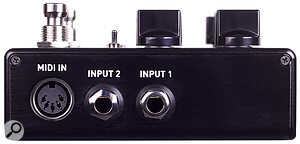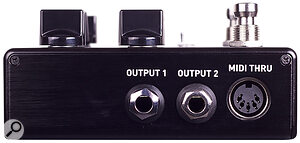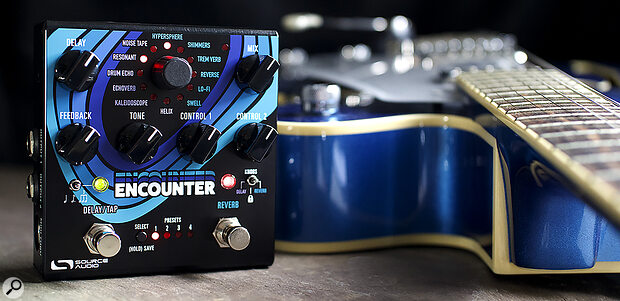This clever dual‑engine effects pedal offers ambience for days!
You might already be familiar with Source Audio’s Collider and Ventris dual‑engine pedals (reviewed in SOS February 2020 and June 2018 respectively), and their new Encounter comes in the same format. Of course, it is loaded with a different set of effect algorithms, and in this case it’s ambient reverb or delay algorithms that can be loaded into either engine. You get a choice of serial or parallel routing options, too.
As with the Collider, this pedal can store up to eight presets that are accessible from the front panel (though the default setting is four), or 128 presets that can be accessed using MIDI. The Encounter can also be integrated with other Source Audio pedals, using their optional Neuro Hub technology, or linked to them using MIDI. There are four preset LEDs and a Select button for stepping through them. If set to Preset Extension mode (eight presets), the LED that is lit shows presets one to four while presets five to eight use an unlit LED to show the preset number.
Source’s Neuro 3 software (iOS, Android, Mac or Windows) has been massively upgraded, and includes a really neat new feature called SoundCheck. This incorporates faithful emulations of all Source Audio’s pedals, along with a series of test phrases played on different instruments that can be run through the virtual pedals. The user can then use Neuro 3 to audition pedals or use the editing function to create patches that can then be shared with other users, saved in a library or saved to a pedal.
Controls & Functionality
 Any permutation of mono and stereo inputs and outputs is possible, while both MIDI in and thru are supported, and there’s a versatile control input jack.
Any permutation of mono and stereo inputs and outputs is possible, while both MIDI in and thru are supported, and there’s a versatile control input jack. The Encounter’s most important functionality can be accessed from the controls on the pedal itself, with no deep menu‑diving involved, but using the Neuro 3 editor allows access to further adjustments that you can’t reach using the front‑panel controls. Onboard MIDI support allows the Encounter to slot into a MIDI‑controlled rig using CC messages to change parameters and Program Change messages to navigate presets.
The Encounter’s most important functionality can be accessed from the controls on the pedal itself, with no deep menu‑diving involved, but using the Neuro 3 editor allows access to further adjustments that you can’t reach using the front‑panel controls. Onboard MIDI support allows the Encounter to slot into a MIDI‑controlled rig using CC messages to change parameters and Program Change messages to navigate presets.
Stereo ins and outs allow for any mono/stereo permutation. If you don’t need to preserve tails, you can use the Analogue mode, which uses a relay to bypass the effect and keeps the dry signal in the analogue domain. A rear‑panel mini–jack Control input, with associated small button, accepts a tap‑tempo switch, a Neuro Hub, a dual expression pedal or, if you have one already, the discontinued Reflex Universal Expression Controller or Hot Hand Motion Controller. A separate...
You are reading one of the locked Subscribers-only articles from our latest 5 issues.
You've read 30% of this article for FREE, so to continue reading...
- ✅ Log in - if you have a Digital Subscription you bought from SoundOnSound.com
- ⬇️ Buy & Download this Single Article in PDF format £0.83 GBP$1.49 USD
For less than the price of a coffee, buy now and immediately download to your computer, tablet or mobile. - ⬇️ ⬇️ ⬇️ Buy & Download the FULL ISSUE PDF
Our 'full SOS magazine' for smartphone/tablet/computer. More info... - 📲 Buy a DIGITAL subscription (or 📖 📲 Print + Digital sub)
Instantly unlock ALL Premium web articles! We often release online-only content.
Visit our ShopStore.

